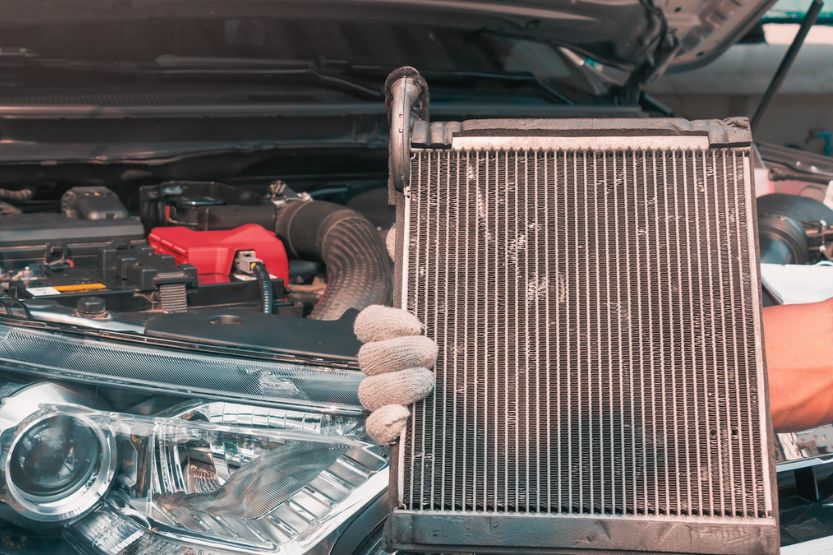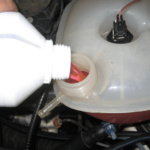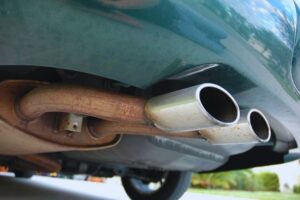A car’s engine is built with a radiator to help cool down the engine. But sometimes, even with enough coolant in your car, it still overheats. Why is this happening?
There may be several reasons your car is overheating, and in some cases, it may come from multiple sources. The components that could be responsible for this problem may include the following:
- Damaged radiator
- Malfunctioning heater core
- Cooling fan
- Fuses
- Water pump
- Water pump belt
- Thermostat
- Bad airflow
Read on to find out the most common reasons why your car overheats even though it has a coolant and the signs to prevent this from happening again.
Why Is My Car Overheating But It Has Coolant in It?

It’s the job of your car’s cooling system to maintain engine temperatures at a level low enough so that the moving mechanical parts will not melt. The ideal temperature for a vehicle is approximately 200°F, but gasoline fires burn at 1733°F.
A vehicle that does not have an adequate cooling system can reach temperatures of up to 400°F, which can cause significant damage to the car.
So why do cooling systems malfunction? The coolant may be the problem. Although you may have enough coolant, it may render unusable if it is old.
Also, your car may overheat for more than one reason. The issue could be due to your vehicle’s radiator, cooling fan, fuses, serpentine belt, water pump, thermostat, or bad airflow.
How Does the Cooling System Work?
Many mechanical parts make up your car’s cooling system. Before we go into the specifics of how these components work and why they can cause your cooling system to malfunction, it will be helpful for you to have a fundamental understanding of how the cooling system functions.
There’s very little to no difference in the cooling system for different vehicles on the road. This is the first thing you should know about cooling systems since they work similarly.
Ideal Operating Temperature
The ideal operating temperature for cars has a specific range. It doesn’t want to be any warmer or cooler than that ideal temperature, which for most vehicles is between 195 and 220°F.
Thermostat Provides Accurate Temperature Reading
Cars don’t want coolants to lower the temperature of an engine that is already too low, so it stops the coolant from getting into the engine.
The thermostat is responsible for taking an accurate reading of the temperatures within the engine. After which, it will either close or open the valve that controls coolant flow.
Thermostat Sends a Signal to the Water Pump
When the thermostat detects that the engine has reached the operating temperature, it sends a signal to the water pump to begin its operation. The water pump pushes the coolant out of the radiator and into the engine’s front.
Coolant Eliminates Heat from Components
After that, the engine coolant makes its way around the cylinders, eliminating heat from those components. At this point, the coolant reaches the head, lowering the temperature of all valves.
Coolant Reenters the Radiator
After going into the cylinders, the fluid is released from the cylinder head and reenters the radiator.
The radiator is a system of thin pipes that circulate the hot coolant throughout the system. It provides a greater surface area for cooling using the airflow generated by the cooling fan and moving vehicle. The coolant is reused after it has cooled, reentering the engine block.
A thermometer serves as a temperature-controlled valve in the car’s engine. The thermostat reads the current temperature and, based on what it senses, either opens or closes a gauge.
Valve Opens More When the Engine Operates at a Higher Temperature
When the engine operates at a higher temperature, the valve opens more. This enables more coolant to pass through and perform its function of lowering heat from the engine block. The thermometer will signal to keep this gauge closed when the engine is cold.
Remember that automakers want their cars to burn fuel efficiently to pass testing and have the highest possible ratings.
Car Temperature Gauge Goes Up and Down While Driving – Main Causes
What Happens If the Cooling System Fails?
Your vehicle can break if it gets too hot. And when it comes to auto repairs, it’s not uncommon for a single issue to trigger many problems.
Radiator cracks, blown head gaskets, and deformed engine parts are all symptoms of a failing vehicle. Because the cooling system’s components depend on one another, eliminating just one will put the remaining components under incredible strain.
Because of this, it’s not unusual to discover various problems inside the vehicle’s cooling system, particularly after the vehicle has experienced an extreme increase in temperature. So when trying to diagnose the issue, it is crucial to conduct thorough checks on the whole cooling system.
Common Factors That Can Cause a Car to Overheat Even with Coolant

Even though you’ve been diligent about keeping your car’s coolant in good shape, you may still face a problem that can’t be solved with a quick top-off: overheating. Here are some common causes of car overheating even with coolant:
- Damaged radiator
- Malfunctioning heater core
- Cooling fan
- Fuses
- Water pump
- Water pump belt
- Thermostat
- Bad airflow
1. Damaged Radiator
How the Radiator Works
The radiator is a component of your vehicle’s cooling system, which allows the hot engine coolant to cool down. After leaving the engine block, the coolant flows through the radiator, constructed out of thin tubes that the coolant travels through.
Small metal pipes give the coolant a lot of surface area in a heat-conductive housing. After that, your vehicle will use the airflow provided by its movement and the cooling fan to eliminate heat from the coolant.
After the engine coolant has been sufficiently cooled, it is circulated through the engine once more to reduce its temperature.
In most cases, you will encounter two problems with your radiator: it will either leak or have clogs that will slow down the coolant’s flow or prohibit it from flowing.
Signs of a Failing Radiator
- Your car overheats;
- There is a coolant leak in your vehicle;
- Your radiator has a sludge buildup; or
- Having a low coolant level even though you don’t think you should.
2. Malfunctioning Heater Core
Overheating can be due to malfunctioning heater cores responsible for defrosting activities and heat transfer from the vehicle’s cooling system to the passenger compartment.
As an extension of your radiator, a heater core is often built of metal piping, either brass or aluminum. This thin piping is what carries the hot coolant.
It helps bring the scalding liquid’s temperature down to a point where it may be recirculated through the engine block. Heater cores appear to be quite similar to a small radiator.
Leak and Decreased Pressure
If your vehicle’s heater core is not functioning correctly, you will not have any heat inside the vehicle. While this lack of heat can be uncomfortable in most cases, it is not the main issue.
Leaking and decreased pressure are two usual problems that can occur with heater core units. Both of these problems will lead to the overheating that you are experiencing.
Signs of a Damaged Heater Core
Check the condition of your heater core by looking for the following telltale signs:
- Overheating vehicle;
- Fog formation on your car’s windshield;
- Going through coolant at an alarming rate; or
- A distinct fruity aroma inside of your vehicle.
3. Cooling Fan
How the Cooling Fan Works
The radiator fan’s function is to draw air across the radiator to hasten the rate of coolant cooling down. Aside from this, your car also uses the natural airflow created by its movement to accomplish its task.
Without adequate airflow, the engine coolant’s temperature will not be able to drop as rapidly and will increase the engine’s temperature.
Signs of a Bad Radiator Fan
- The engine overheats when the vehicle stops for a long time;
- Your engine is running a little bit too hot;
- Warning lights are turned on; or
- The AC is blowing warm air.
4. Fuses
What the Fuse Does
The fuses in your vehicle all do much the same function. Fuses help safeguard your vehicle’s electrical system. One fuse box is usually located in the engine block, while the other is in the car’s cab.
The fuses for the various electrical components, including the cooling fans, are kept in the fuse box, which is located in the engine compartment.
A blown fuse prevents power from being supplied through the various electrical system components. If the fuse is bad, the cooling fan won’t work.
Signs of a Bad Fuse in the Cooling System
- A cooling fan won’t operate;
- Your engine is running a little bit too hot;
- The engine overheats when the vehicle stops for a long time;
- The AC is blowing warm air; and
- Warning lights are turned on.
5. Water Pump
Functions of a Water Pump
The water pump that comes standard in vehicles is quite powerful! It can completely remove all water from a small swimming pool in about an hour. This means the coolant will be wholly recirculated in your car twenty times every minute.
If the engine coolant isn’t being circulated effectively, it may begin to boil, rendering it ineffective in taking heat from your running vehicle. This results in an overheating engine.
Common Water Pump Issues
- Leaks
- Erosion
Signs of a Failing Water Pump
- Overheating engine
- Steam release through the cooling system
- Coolant leak at the vehicle’s front center
- Visible corrosion and rust on the water pump
- Noise coming from the belt
Again, why is my car overheating, but it has coolant in it? If your car has a coolant but still overheats, then the coolant isn’t circulating. This might be due to a damaged water pump, blocked radiator, plugged heater core, or a stuck thermostat.
6. Water Pump Belt
Serpentine Belt Provides the Water Pump’s Power
A belt referred to as the serpentine belt provides the power for the water pump. The car’s serpentine belt provides power to multiple critical components all at the same time. It is the job of the belt to distribute the power generated by the engine to other components of the vehicle, such as:
- The electrical system
- Power steering system
- Air conditioning system
- Cooling system
In some automobiles, the serpentine belt is also used to power the vehicle’s power-assisted braking system. Also, the water pump belt provides the power that drives coolant flow, pushing it through the cooling system. If there are problems with the belt, it could cause the engine to overheat.
Common Water Pump Belt Problems
- Whirring or whining noise
- Worn out
- Breaking
Effects of a Broken Water Pump Belt
In most cases, the entire water pump will be powerless if the serpentine belt fails. In these situations, even if you can still drive your car, the engine coolant will not be forced into the radiator to be cooled off.
This will result in the coolant coming to a boil. In addition to these other issues, the vehicle’s engine will overheat.
Broken Serpentine Belt Symptoms
- No power assist in your car’s steering system.
- Engine overheating due to poor coolant circulation
- Decreased power supplied to the electrical system
- The alternator produces no power
- Dead battery
- Non-functioning radio
- Dimmed lights
7. Thermostat
What Does the Thermostat Do?
As mentioned earlier, the thermostat is responsible for reading the engine’s temperature and determining when it is safe to allow the coolant to circulate through the system.
When you start your car, the coolant is kept out as it needs to warm up first. The thermostat will open after the ideal temperatures have been reached.
If your thermostat is malfunctioning and always reads that your engine is cold, it will prevent the coolant from circulating. The engine will overheat regardless of whether the coolant is stuck in the radiator or the engine block. Both situations lead to the same outcome.
Common Thermostat-related Problems
- Unreliable temperature readings
- Getting stuck in the on/off position
- Coolant leaks around the thermostat
- Surface scaling and corrosion
Signs of a Faulty Thermostat
- Overheating engine
- Inconsistent temperature measurements
- Leaking underneath the vehicle and all around the thermostat
8. Bad Airflow
Why Your Car Needs Airflow
As discussed earlier, adequate airflow is necessary for the radiator to effectively remove heat from the hot coolant. Cars use the air created by their movement and air blown by the cooling fan onto the radiator.
When there is blocked airflow, the coolant will not have the opportunity to adequately cool off before being exposed to an increase in temperature. If the issue is serious enough, the coolant will boil, resulting in an overheating engine.
Your vehicle’s primary air intake is the front grate, which can become clogged with debris like leaves and dirt, restricting proper airflow.
Signs of Bad Airflow to Your Cooling System
- Overheating car
- The coolant still boils even though the coolant integrity is good
Frequently Asked Questions – Car Overheating Even Though It Has Coolant

Why Would My Car Overheat If It Has Coolant in It?
There are many potential causes for a vehicle to overheat. This includes leaks in the cooling system, clogged hoses due to mineral deposits and corrosion, radiator problems, and broken water pumps.
In the long run, preventative maintenance, like regular inspections, might save you from overheating problems.
Why Is My Car Overheating, but It Has Coolant and New Thermostat?
Suppose your car is overheating despite having a new thermostat. The problem may be caused by a clog in your radiator or heater core, a faulty water pump, a broken radiator, or coolant-related issues.
Do not drive your vehicle until the problem has been resolved. This is the first and most critical step to take.
Can Too Much Coolant Cause Overheating?
Going below the minimum mark could result in overheating issues for your engine. On the other hand, if you fill your coolant tank more than the maximum level while the coolant is still cold, there will be no room for the coolant to expand into as the temperature rises.
How Long Can a Vehicle Overheat Before Damage?
An overheated car takes only 30-60 seconds to cause irreparable engine damage. If it becomes hot enough, the vehicle will blow a piston or soon seize its valves.
Will My Engine Be OK After Overheating?
If you’re driving and suddenly notice that your car is overheating, you should pull over, shut it down, and call for help. Don’t drive your car unless it is necessary.
Conclusion – Why Is My Car with Coolant Overheating?
If you’re concerned about your car overheating and you’ve checked the coolant levels, there are several things you can check to make sure there’s nothing else causing the problem. These include:
- Damaged radiator
- Malfunctioning heater core
- Cooling fan
- Fuses
- Water pump
- Water pump belt
- Thermostat
- Bad airflow
You’ll want to ensure that you replace any damaged parts, so your engine doesn’t suffer further damage. Also, work with a mechanic to get everything back up and running smoothly again.
Read next:


![Car Won’t Turn Over but Has Power [Causes and How to Fix] car wont turn over but has power](https://roadsumo.com/wp-content/uploads/2022/04/car-wont-turn-over-but-has-power-150x150.jpg)
![Oil in Coolant [Causes and Solutions to Coolant in Oil] oil in coolant](https://roadsumo.com/wp-content/uploads/2021/10/oil-in-coolant-150x150.jpg)

![Toyota Long Life Coolant and Super Long Life Coolant [Review] toyota long life coolant](https://roadsumo.com/wp-content/uploads/2021/07/toyota-long-life-coolant-150x150.jpg)


![Read more about the article Car AC Stopped Working Suddenly [Not Blowing Cold Air]](https://roadsumo.com/wp-content/uploads/2021/01/car-ac-stopped-blowing-cold-air-all-of-a-sudden-300x200.jpg)
